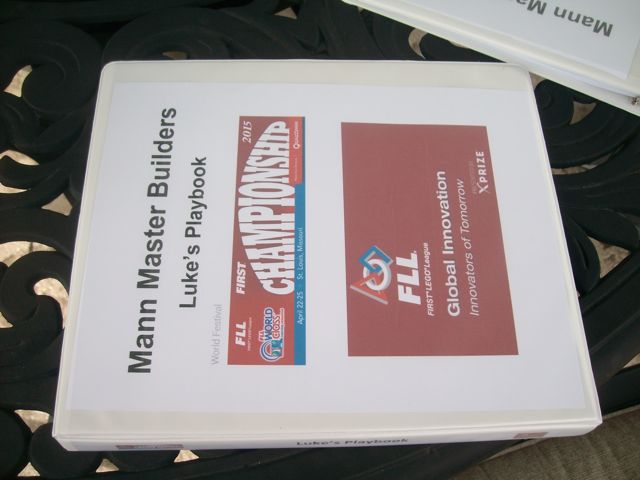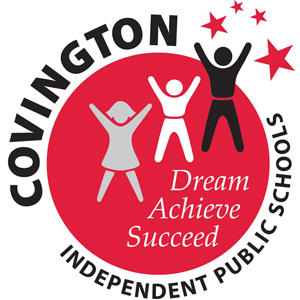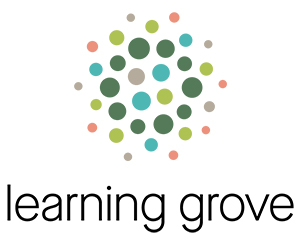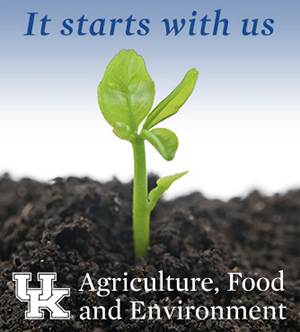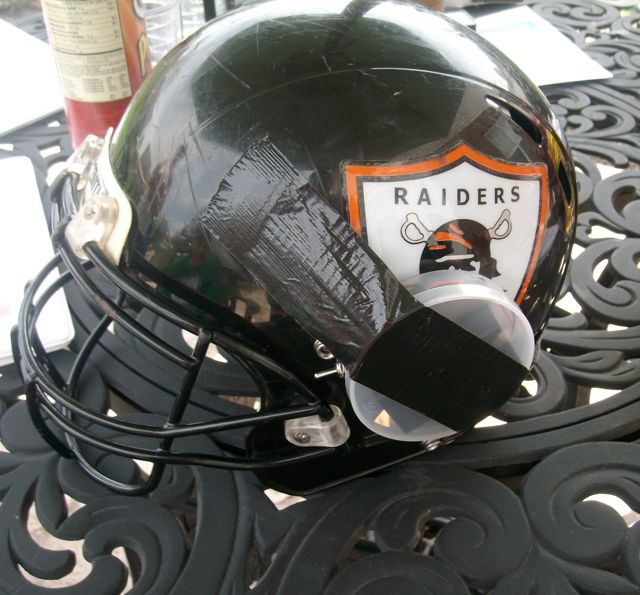
The Safe Tackle Football Helmet teaches players how to tackle with their heads up. Experts say tackling with the head up can reduce the risk of injury. (Photo by Mark Hansel)
By Mark Hansel
NKyTribune contributor
A group of Mann Elementary students from Union might help provide a solution to an issue that is threatening one of America’s most popular sports.
The students, five fourth-graders and one fifth-grader, have developed the Safe Tackle Football Helmet, which teaches players how to tackle with their heads up — and, they hope, reduce the risk of head injuries.
Concern over head injuries, particularly concussions, is perhaps the biggest issue facing the National Football League – and football at all levels. Experts say seeing what you hit, or tackling with the head up, can greatly reduce the risk of injury.
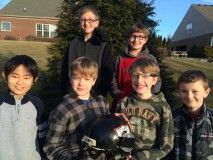
The Mann Master Builders team, front row from left, Chihiro Iwata, Luke Zurad, Guy Manaugh, Logan Dyer; back row Tyler Seibert, Christopher Howard. (Photo provided)
The youngsters, along with an entourage of family and friends, are headed to St. Louis this week to present their Safe Tackle Football Helmet at the First Lego League Global Innovation Award competition.
The helmet includes a modification that alerts players when their head dips below a certain level and over time, should help condition them to use the safer hitting technique.
First Lego League introduces youngsters between the ages of 9 and 14 (the age limit is 16 for international teams) about the fun and excitement of science and technology. More than 25,000 teams from 80 countries compete in First Lego League events.
The Boone County students, whose team name is Mann Master Builders, were chosen as one of 20 semifinalists from among 527 teams that submitted ideas for the FLL Global Innovation Award.
Contrary to the name, not all of the competitors work with Legos. Global Innovation contestants focus on developing innovative solutions to a real-world problem.
The wide-ranging ideas from other semifinalists include a process to improve the way blind children learn Braille and a Math Magic game that makes arithmetic fun.
— Coach Matt Zurad
Mann Master Builders is coached by Matt Zurad and Melody Manaugh, whose sons, Luke Zurad, 10, and Guy Manaugh Jr., 9, are on the team. Other team members include Tyler Seibert, 10, Chihiro Iwata, 10, Logan Dyer, 10 and Christopher Howard, 9.
“We’re a rookie team, both the coaches and the players,” Matt Zurad said. “We just followed the road map, from the regionals to the state and now the global competition.”
The team was formed in September and came up with about 20 ideas for the competition.
Seibert suggested the heads-up idea because his grandfather is a huge college football fan and he had heard about the concerns over head injuries. Coincidentally, Luke Zurad had some information on the subject with him at the first meeting.
“At our first practice, I had a Scholastic News magazine for homework and the main cover was about heads up-heads down football,” Zurad said. “We took a vote and the head-up football idea won.”
The team started thinking about ways to condition players to tackle with their heads up and decided a device in the helmet that would alert players when their head dropped was the best method.
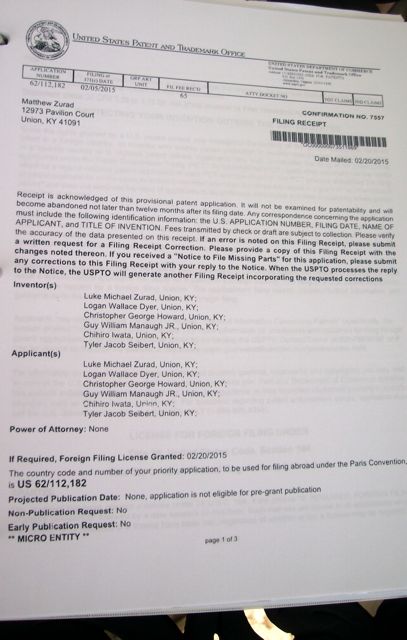
The team received a provisional patent to protect the Safe Tackle Football Helmet. (Photo by Mark Hansel)
Manaugh said that initially the project itself was not their favorite part of being on a First Lego League team.
“They wanted to go with Coach Matt and play with the robot, they didn’t want to go with Coach Melody and do the research,” Manaugh said. “Now every time we get together, they are focused on how they can improve it.”
The group started with a pen as a tilt-switch and used BBs to complete an electrical circuit, but the technique was flawed, so they continued to refine the process. Subsequent models, or generations, included a working tilt switch, a battery, an on-off switch to protect battery life and a buzzer that alerts the wearer when the head drops below a certain level.
The team received a lot of support along the way. Ryle High School varsity football coach Mike Engler visited the team and provided information about the dangers of concussions.
“What I thought was pretty cool is that you can actually see stars over your head when you have a concussion,” Luke Zurad said. “I thought that was only in cartoons.”
None of the team members plays football, but a message that resonated strongly with the youngsters was a story they heard about a first-grader that suffered a concussion while playing. They previously thought only older children and adults were susceptible to head injuries playing football. The realization that children their age or younger could also be hurt motivated them even more.
Every year the competition focuses on a different theme and, this time around, it was how to teach a group of people to do something better. At the regional competition in December the team won the Most Innovative Solution Award.
“I was playing Minecraft on the computer and dad got a call and started jumping up and down,” Luke Zurad said.
It was about that time that the team began to recognize the potential of the Safe Tackle Football Helmet. “We kind of had the (Global Innovation Award) on our radar, so we decided to go to the state competition in February and do our best,” Matt Zurad said.
The team won the Innovative Solution Award at the 2014-2015 FLL Kentucky State Championship Tournament at Northern Kentucky University and was chosen to compete in the Global competition. Mann Master Builders followed the recommendation of FLL and applied for a provisional patent, which was granted in February, to help protect their idea. The patent, which is placeholder for one year, lists the six kids are listed as the inventors.
The Global Innovation Award contest is a STEM – science, technology, engineering and mathematics – competition. Contestants are judged on four criteria: problem identification, innovation, implementation and effective use of STEM principles.
The teams practice in St. Louis Thursday and the competition takes place Friday.
Mann Master Builders will participate in a five-minute skit, during which each team member plays a role. The judges will then get 15 minutes to critique the invention and ask questions.
The team members know the competition will be stiff because some teams have been together much longer and many of the other semifinalists are much older. But they are confident in the product.
Regardless of what happens at the competition, Mann Master Builders plans to continue to work on improving the Safe Tackle Football Helmet, with the ultimate goal of bringing it to market.
“In some people’s minds, we are way down the road and already thinking about how we can get it to market,” Manaugh said. “Around generation seven, we might be ready to go to Shark Tank.”
A good showing at the Global competition could help the group get to “Shark Tank,” the reality-based television show that lets aspiring entrepreneurs make business presentations to a panel of investors.
Three finalists will be named on Friday night and will have an opportunity to go to Washington, D.C., in June where a winner will be named.
The first place team gets $20,000, and the second- and third-place teams each receive $5,000, with the recommendation that it be used as seed money to help bring the invention to market.




